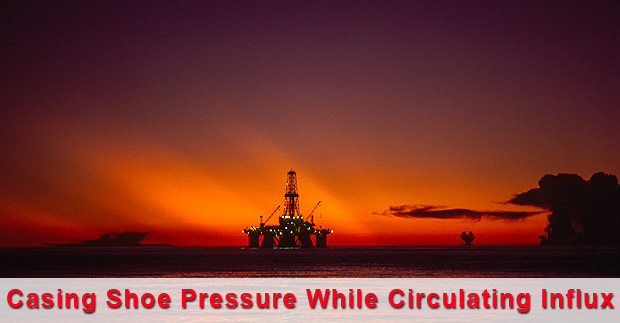Many people ask us a lot of questions regarding shoe pressure while circulating kick (wellbore influx) out of the wellbore. Pressure acting at casing shoe is different depending on where the kick is in the well therefore we will summarize all the scenarios to help you get clearer picture. There are a total of three cases which we will separately discuss as per the details below.
Note: All the calculations and scenarios are based on water based mud and gas kick. This assumption is used because it is the worst case scenario. The casing shoe will have less pressure if the influx is oil or gas kick.

First Scenario – Top of Gas Kick Below Casing Shoe

Figure 1 – Top of Gas Kick Below Casing Shoe
As you can see in Figure 1, hydrostatic pressure above the casing shoe remained constantly because the fluid column is the same. The overall hydrostatic pressure in the well will decrease because gas expansion when it is being circulated. In order to maintain the bottom hole pressure constant, casing pressure will increase to balance the loss of hydrostatic pressure in the wellbore due to expansion.
The equation below is relationship between hydrostatic pressure, casing pressure and bottom hole pressure.
Bottom Hole Pressure = Casing Pressure + Hydrostatic Pressure in Annulus
Let’s take a look at casing shoe and we can write the relationship as follows;
Pressure at Casing Shoe = Hydrostatic Pressure Above Shoe + Casing Pressure
If the gas influx is still below the casing shoe, the hydrostatic pressure is the same and the casing pressure will increase; therefore, pressure at shoe will increase and the shoe pressure will reach the highest pressure when the gas influx reaches the casing shoe.
Conclusion: Casing shoe pressure will increase until the top of the bubble reaches the casing shoe.
Second Scenario – Shoe Pressure When the Gas Kick Passing Shoe
For this case, we will consider the shoe pressure when the gas kick is passing the casing shoe (see Figure 2).

Figure 2 – Shoe Pressure When the Gas Kick Passing Shoe
Let’s apply the hydrostatic pressure concept.
The formula for the bottom hole pressure is listed below:
Bottom Hole Pressure = Pressure at Casing Shoe + Hydrostatic Pressure Underneath Casing Shoe
While circulating kick, we keep the bottom hole pressure constant therefore the equation will look like this
Bottom Hole Pressure (constant while circulating) = Pressure at Casing Shoe + Hydrostatic Pressure Underneath Casing Shoe
While the gas kick is passing the shoe, the hydrostatic pressure in the open hole underneath casing shoe will increase because mud column underneath the shoe increases. Therefore, in order to maintain bottom hole pressure constant, the shoe pressure will decrease.
Note: we don’t select use the same equation in the first scenario (Pressure at Casing Shoe = Hydrostatic Pressure Above Shoe + Casing Pressure) to analyze shoe pressure for this case because of following issues;
- Hydrostatic pressure always decreases while the gas moves up.
- Casing pressure always increases while the gas moves up.
Therefore we cannot make find the definite answer regarding shoe pressure from the equation used in the first scenario.
Conclusion: Pressure at shoe will decrease when gas bubble passing the shoe.
Third Scenario – Shoe Pressure When Gas Kick Above Shoe
The last scenario is shoe pressure when gas is above the casing shoe (see Figure 3).

Figure 3 – Shoe Pressure When Gas Kick Above Shoe
Again let’s apply the hydrostatic pressure concept,
Bottom Hole Pressure = Pressure at Casing Shoe + Hydrostatic Pressure Underneath Casing Shoe
The concept while circulating kick is the same. It means that you must keep bottom hole pressure constant. Therefore, you can write the equation like this:
BHP (constant while circulating) = Hydrostatic Pressure at Shoe + Hydrostatic Pressure Underneath Casing Shoe
Re-arrange the equation like this;
Hydrostatic Pressure at Shoe = BHP (constant while circulating) – Hydrostatic Pressure Underneath Casing Shoe
While kick is above the shoe, the hydrostatic pressure below the casing shoe will remain constant because there is no change in fluid density. Therefore, casing shoe pressure will remain constant once the gas is above the shoe.
Conclusion: Shoe pressure will remain constant after the gas kick is above the casing shoe.
Summary:
Shoe Pressure When the Gas Kick Passing Shoe => Casing shoe pressure will increase until the top of the bubble reaches the casing shoe.
Shoe Pressure When Gas Kick Above Shoe => Pressure at shoe will decrease when gas bubble passing the shoe.
Shoe Pressure When Gas Kick Above Shoe => Shoe pressure will remain constant after the gas kick is above the casing shoe.
Reference book:  Well Control Books
Well Control Books








That is an useful tool for learning.
excellent explanation,
thanks